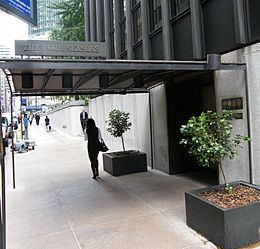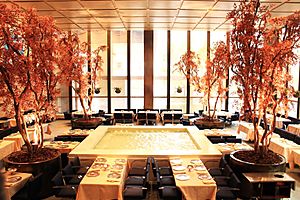The Four Seasons Restaurant facts for kids
Quick facts for kids The Four Seasons |
|
|---|---|

Original 52nd Street entrance to the Four Seasons Restaurant
|
|
| Restaurant information | |
| Established | 1959 |
| Closed | 2019 |
| Current owner(s) | The Bronfman family, Alex von Bidder, and Julian Niccolini |
| Chef | See web |
| Food type | New American cuisine |
| Street address | 42 East 49th Street, Midtown Manhattan |
| City | New York City |
| State | New York |
| Coordinates | 40°45′29″N 73°58′19.5″W / 40.75806°N 73.972083°W |
| Other information | Closed |
The Four Seasons was a famous restaurant in New York City that served New American cuisine. It opened in 1959 and was first located at 99 East 52nd Street inside the Seagram Building in Midtown Manhattan. Later, from 2018 until it closed in 2019, it moved to 42 East 49th Street in Midtown Manhattan.
The restaurant was known for being very special in the hospitality industry (which means the business of serving guests). It was one of the first places in America to change its menu with the seasons. It was also the first fancy restaurant to print its menus in English. The Four Seasons won many awards, including the James Beard Foundation Award, which is a big honor for restaurants.
The inside of the restaurant was designed by the building's architects, Ludwig Mies van der Rohe and Philip Johnson. It looked almost the same from when it opened in 1959 until it closed. It had amazing art, including paintings by Mark Rothko and a large sculpture by Richard Lippold. There was even a curtain designed by the famous artist Pablo Picasso. Because of its unique design, the restaurant's interior was named an "interior landmark" by the New York City Landmarks Preservation Commission in 1989.
Contents
History of The Four Seasons Restaurant
Early Years (20th Century)
The Four Seasons restaurant was created by Joseph Baum of Restaurant Associates in 1959. It was built on the ground floor of the Seagram Building. The restaurant was incredibly expensive to build, costing a lot of money at the time.
By 1973, the original owners decided to sell the restaurant. Tom Margittai and Paul Kovi took over The Four Seasons.
In 1977, a book publisher named Michael Korda said the restaurant's Grill Room was "the most powerful place to eat lunch in town." An article in Esquire magazine in 1979 called its Grill Room the spot for "America’s Most Powerful Lunch." This is where the term "power lunch" (a business lunch where important decisions are made) is believed to have come from.
In 1994, Margittai and Kovi handed over the restaurant to their partners, Alex von Bidder and Julian Niccolini. They continued to run The Four Seasons in the Seagram Building until 2016.
Closing Down
In June 2015, the owner of the Seagram Building, Aby Rosen, announced that the restaurant's lease would not be renewed. This meant The Four Seasons had to leave its long-time home. The restaurant at the Seagram Building location closed its doors after dinner on July 16, 2016.
After it closed, almost everything inside the restaurant was sold at an auction in New York. People bought many items, from furniture to small decorations. The sale brought in much more money than expected, showing how famous and loved the restaurant's items were.
In August 2018, The Four Seasons opened again at a new, smaller location in Midtown Manhattan. The new space was designed by a Brazilian architect named Isay Weinfeld. It cost a lot of money to build, but it tried to bring back many of the famous design ideas from the old restaurant.
However, the new location did not last long. The Four Seasons closed permanently on June 11, 2019. Now, two new restaurants are in the old Seagram Building space where The Four Seasons used to be.
Special Food and Menus
The Four Seasons was known for doing new things in the restaurant world. It was famous for being the first restaurant in America to change its menu based on the different seasons. This meant they used fresh ingredients that were available at that time of year.
James Beard, a very important person in American cooking, helped create this idea of seasonal food for The Four Seasons. He also suggested pairing American wines with the food, which was new for a fancy restaurant. It was also the first major restaurant to print its menus in English, making it easier for everyone to understand.
The Four Seasons was also the first restaurant in the United States to cook with fresh, wild mushrooms. It helped start a style of cooking that later became known as "New American Cuisine." This style focused on using fresh, local ingredients in new and creative ways.
One fun and unique dessert that was a specialty of the restaurant was cotton candy.
Famous Visitors
Many people thought the main reason to go to The Four Seasons wasn't just the food, but who you would see there. It became a place where important and powerful people gathered.
Because of its location in Midtown, it was a perfect spot for "power lunches." These were lunches where important business people and leaders met to talk and make deals.
Many famous people were regular customers. These included Anna Wintour, Henry Kissinger, Martha Stewart, Bill Clinton, and Jackie Kennedy. The architect Philip Johnson, who helped design the restaurant, even ate lunch there every day at a special table.
Unique Design
The inside of The Four Seasons was designed by the building's architects, Ludwig Mies van der Rohe and Philip Johnson. It looked almost exactly the same from when it opened in 1959. In 1989, the New York City Landmarks Preservation Commission named the restaurant's interior a special "landmark."
The restaurant had two large rooms, each about 60 feet by 60 feet, with very high ceilings (20 feet tall!). The Grill Room had beautiful French walnut wood panels and two detailed metal sculptures by Richard Lippold. Between the two rooms, there was a huge stage curtain called "Le Tricorne" (1919), which Pablo Picasso painted for a ballet.
The Pool Room had a white, 20-foot by 20-foot marble pool in the middle. There were ornamental trees at the corners of the pool. These trees were changed to match the different seasons. In both rooms, the windows had special metal curtains that moved gently from air coming out of hidden vents. The lighting in the ceiling could also be changed to fit the time of day or the season.
Even the dishes and serving items were specially designed for the restaurant. Over a hundred different items, from champagne glasses to bread trays, were created by L. Garth Huxtable and Ada Louise Huxtable. Today, these items and all the furniture from The Four Seasons Restaurant are part of the permanent collection at the Museum of Modern Art.
For the restaurant's 50th anniversary, an architect named Belmont Freeman helped restore the ladies' lounge, making sure it looked perfect.
Awards and Honors
The Four Seasons restaurant received many awards and was highly praised. It won the James Beard Foundation Award several times.
- In 1997, it won for "Outstanding Wine Service."
- In 1998, it won for "Outstanding Service."
- In 1999, it was called an "Outstanding Restaurant."
- In 2016, it was recognized as a "Design Icon" for its amazing interior.


